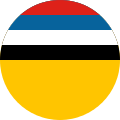Manchukuo Air Force
| Manchukuo Imperial Air Force | |
|---|---|
|
Nakajima (Mansyū) Ki-27, the most common fighter in service in the Manchukuo Imperial Air Force | |
| Active | 1932 (de facto)/February 1937 (officially) – 1945 |
| Country | Manchukuo |
| Engagements | World War II |
| Commanders | |
| Ceremonial chief | Emperor Puyi |
| Insignia | |
| Roundel |
 |
The Manchukuo Imperial Air Force (Chinese: 大満州帝国空軍; pinyin: Dà Mǎnzhōu Dìguó Kōngjūn) was established in February 1937 with 30 men selected from the Manchukuo Imperial Army who were trained at the Japanese Kwantung Army aircraft arsenal in Harbin. The air force's predecessor was the Manchukuo Air Transport Company (later renamed the Manchukuo National Airways) a paramilitary airline formed in 1931, which undertook transport and reconnaissance missions for the Japanese military.
The first air unit of the Manchukuo Air Force was established at the airfield in Xinjing, under the command of 1st Lieutenant Uta, with only one aircraft: a French-built Nieuport-Delage NiD 29 biplane. Kawasaki Type 88 (KDA-2) light bombers and Nakajima Type 91 fighters were later supplied from Japan.
A second air unit was established in Fengtien and the third air unit in Harbin in 1938-1939. In July 1940, an Air Defense HQ was created in Hsinking.
Until 1940, only Japanese pilots and ground crews were deployed. After 1940, the Japanese allowed native ethnic Manchus to receive pilot training. On 30 August 1940, a flight school was established in Fengtien to teach military and civil pilots. The training program received a severe setback in January 1941 when approximately 100 pilot cadets rebelled, and fled to join to anti-Japanese guerillas after killing their instructors. During September to October 1942 the school received more than twenty training aircraft, including Tachikawa Ki-9 "Spruce", Tachikawa Ki-55 "Ida" and Mansyū Ki-79 advanced trainers
In addition, a transport section with three Nakajima Ki-34 "Thora" passenger aircraft was established to serve the needs of the imperial court. Additional Junkers Ju-86Z-2, Tachikawa Ki-54 "Hickory" and Manshū Hayabusa provided for government transportation needs.
From 1944, the Manchukuo Imperial Air Force came under the command of the Japanese 2nd Air Army. At that point, it had around 100 to 120 combat aircraft.
From 1941 to the end of World War II, the main equipment of the Manchukuo Air Force was the Nakajima Ki-27b "Nate" light fighter. Money to pay for these fighters was “donated” by various Japanese companies based in Manchukuo. Primarily a fighter force, the only tactical bomber in Manchukuo service during World War II was the Kawasaki Ki-32 "Mary".
The Manchukuo Air Force requested Type 1 Nakajima Ki-43 IIa Hayabusa "Oscar" and Type 2 Nakajima Ki-44 IIb Shoki "Tojo" fighter/interceptors from Japan in early 1945. However, these more advanced aircraft were supplied in only small numbers.
As American air raids against Manchukuo increased in frequency towards the end of the war, the Manchukuo Air Force resorted to kamikaze tactics, with the first successful ramming attack (by a Ki-27) on a US Army Air Force B-29 Superfortress strategic bomber occurring in December 1944. The Manchukuo Air Force also suffered from a chronic shortage of fuel, as Japanese military aviation had first claim to supplies.
In 1945, the American air raids against Manchuria decreased and the threat of the Soviet invasion increased. The Manchukuo Air Force changed its training from interception to emphasize ground attack against armored vehicles. During the Soviet Union's invasion of Manchukuo, the Japanese 2nd Air Army ordered the Manchukuo Air Force to train for suicide attacks against Soviet tanks. However, the war ended before attack plans could be executed.
See also
References
- Green, William (1997). Flying Colors. Motorbooks International. ISBN 0-7603-1129-3.
- Jowett, Philipp (2005). Rays of the Rising Sun, Volume 1: Japan's Asian Allies 1931-45, China and Manchukuo. Helion and Company Ltd. ISBN 1-874622-21-3.
